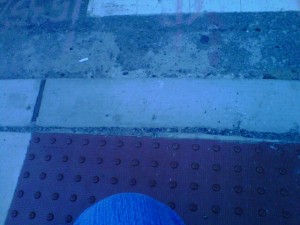Election night coverage from students at The College of New Jersey
Three Ways News Organizations Can Put Citizens Before Politicians in Political Reporting
A visitor from outer space exposed to major news coverage the 2012 US elections might be forgiven for thinking that the President’s job description is the Namecaller-in-Chief. Presumptive Republican presidential nominee Mitt Romney tries to paint Pres. Barack Obama as a feckless leader an enemy of American free enterprise at home and exceptionalism abroad. For his part, the President has tried to define Romney as a political opportunist and vulture capitalist whose company profited from eliminating American workers’ jobs and shipping them abroad. New York University journalism professor Jay Rosen suggests the Romney camp is likely running a “post-truth” campaign. Pollsters say the attacks leave voters disaffected with both candidates.
As Factcheck.org notes, the campaign has become not just mean-spirited, but trivial:
“Besides being marked by a cavalier disregard for facts on both sides, the campaign also has become bitter and trivial. It is failing to engage the public in a fact-based discussion of the hard choices that will very soon be forced on Washington.
“In its triviality, the 2012 campaign so far resembles the infamous 1988 contest that pitted George H.W. Bush against Michael Dukakis. The ‘issues’ featured then included Dukakis’ support for a state prison furlough program and Bush’s knowledge (or lack of it) about aid to Nicaraguan rebels. Neither side said much about an unfolding debacle in the U.S. Savings and Loan industry, which eventually cost taxpayers more than $130 billion.
“This time the real issues facing the country are much bigger: A lagging recovery from the worst recession since the 1930s, a string of $1-trillion-plus deficits, inexorably rising medical costs that burden both state and federal taxpayers, and a Social Security system unable to pay full benefits for more than another 20 years or so. Just to name a few.”
It’s enough to make conscientious political journalists and commentators sick. Alex MacGillis despairs that journalists seem to have grown weary of holding the candidates’ feet to the fire for their campaign’s false and misleading statements.
All indications are that the vitriol will only increase as we stagger toward Election Day. What are responsible journalists and their spin-weary audiences to do? Here are three thoughts:
1. Shorten the shelf-life of the spin-counter-spin stories. Granted, when the candidates or their surrogates make claims about the other candidates, the press has to give it some attention. But fact-check the claim up front, and include the conclusions of that fact-checking in subsequent reporting.
2. Get to the policy questions implicit in the attack ads – and stay there. For example, with all that we’ve heard about outsourcing this election season, I would have hoped for some discussion of the proposed Bring Jobs Home Act, which was spiked by Senate Republicans earlier this month. The Obama administration backed bill would have ended tax breaks for companies that send jobs overseas and offered breaks for companies that create jobs in the US. I haven’t found evidence that Romney’s taken a position on the issue.
Similarly, there seems to be broad recognition that Obama’s recent comments that entrepreneurs don’t succeed on their own is simply an argument that public investment can help private enterprise. Romney has made the same point himself. So the real debate is over the extent and nature of the kinds of investments the candidates support. That’s the question that needs to be continually asked, and those are proposals that need to be scrutinized.
3. More policy experts and voters’ voices, fewer political strategists, please. Stop focusing so many stories on what the candidate’s attack ads and speeches mean for their campaigns. Stop asking reporters to be commentators speculating on the candidates’ thoughts and attitudes. When a candidate advances a policy position, stick to the evidence about the soundness of the policy, instead of worrying so much about how the idea will play with some segment of the electorate. We should be seeing a lot more of the kinds of questions raised by Nieman Watchdog’s Ask This column, and a lot less focus on speculation and spin.
Curb Cut Alert!
A three-block walk through Center City Philadelphia turned into a 25-minute obstacle course yesterday because of street repairs. While I appreciate the efforts put into street maintenance, what constitutes a minor inconvenience to most people can turn into a real challenge and safety issue for mobility-impaired individuals.

I spend a lot of time navigating the streets of old East Coast cities – Philadelphia, Pa.; Trenton, New Jersey; and New York City especially — and I sometimes travel by wheelchair. On more than one occasion, I’ve been forced to detour or take unsafe routes because curb cuts were either non-existent, poorly maintained or compromised by street construction or other obstacles. I’ve decided to create a social media platform for documenting these obstacles. I’m calling it Curb Cut Alert! because I’d like this to become a tool that allows people in chairs to navigate more safely.
Starting with Center City Philadelphia, I’ll map the obstacles that I come across, and share them via twitter using the #CurbCutAlert hashtag. I’ll run a twitter feed on my site to pick up information from other sources as well. Ideally, I want others to be able to add information easily, but this is my first use of MapPress, so I will take it one step at a time and see how it goes.
[mappress mapid=”1″]
What’s the right hyperlocal news model for journalism education?
The Algebra Project – a model for education reform and community engagement
I spent the past weekend with pioneers – high school students, educators, community activists and policy makers associated with the Algebra Project, the innovative initiative founded by Civil Rights icon Bob Moses that combines culturally responsive pedagogy with the grassroots organizing tactics of the Civil Rights Movement. Moses is best known for his role in “Freedom Summer,” a 1964 voting rights movement that played a significant role in the passage of the 1965 Voting Rights Act. One of key components of Freedom Summer was the creation of Freedom Schools, which brought literacy to thousands of sharecroppers so that they would be equipped to exercise their rights to vote and to participate more fully in American life. (This site archives the Freedom Schools curriculum.)
I came away profoundly impressed by the results that that Moses and his small team have achieved over the last 30 years, both in terms of research data and the testimonies of the young people whose lives have been transformed by their participation in the program. The Project’s own studies, testimonials from students and teachers, and independent research all confirm that Algebra Project participants achieve higher test scores, and are more likely to take advanced math classes in high school and college. What is most remarkable about all of this is that the project targets students who are in the bottom quartile of their 8th-grade math class. (See the “More Information” section below for links to evaluation studies and related research.)

In a presentation of her research on the Algebra Project site in Mansfield, Ohio, Erica N. Walker, Associate Professor of Mathematics Education at Columbia Teachers’ College, found it to be an effective model for building math learning communities. These learning communities are especially critical non-Asian students of color, who rarely see images of people who look like them who are successful at math. In fact, as Walker wrote in her essay, “Challenging Limiting Assumptions: Higher-Quality Mathematics for Underserved Students (.pdf),” all too often, teachers and school leaders assume that low-income students and students of color are incapable of learning higher level math. As a result they pass along students with credits in say, geometry who have never been asked to solve a proof.
Walker delves into these issues in more detail in her new book, “Buliding Mathematics Learning Communities: Improving Outcomes in Urban High Schools” from Teachers’ College Press.
What the Algebra Project does
The Algebra Project and its spin-off, the Young People’s Project, develop culturally responsive curricula, train teachers and organizes communities around math literacy. The implementation of Algebra Project pedagogy and curricula varies according the resources of the particular sites in which it takes place, at its center is the “cohort model.” Its components include:
- Students take math together from 9-12th grade, in 90-minute classes.
- They participate in after school and summer programs created and conducted with the support of community organizations.
- Algebra Project curricular materials are used.
- Group and/or individual psychosocial support is provided as needed.
One of the many remarkable features of the Algebra Project model is that in many instances, the project’s youth workers actually teach classes, with the classroom teacher as a resource person. In addition, high-school students might be pressed into service to teach middle-school students, and middle-schoolers might be expected to teacher elementary-schoolers.
In addition to the Algebra Project site, a separate, youth-run spin-off, the Baltimore Algebra Project, adds political advocacy for education funding to education program. In addition their in-school and after-school activities, they have, in the past, held sit-ins and hunger strikes to demand better funding for public education.
David Henderson, a Cornell University math professor who is part of a team working with the Algebra Project on curriculum development, sums up its fundamental mission succinctly in this summary(.pdf) of an National Science Foundation-funded program to further develop and evaluate its educational model:
“The Algebra Project seeks to stimulate a demand for math literacy in those most affected by its absence — the young people themselves. It stresses the importance of peer culture, using lessons learned from the 1960s Civil Rights Movement, as well as the emergence of project graduates into a group with their own perspectives and initiatives.”
Here’s how one of the leaders of the Baltimore Algebra Project, Ralikh Hayes, put it:
“We want to see Algebra Project pedagogy implemented in every school in this country — because it works.”
The Algebra Project in Action
Some of the students, professors and teachers I met this weekend are in these videos. (I wasn’t there as a journalist, so I didn’t record my conversations, but a number of the people in these videos were part of this weekend’s meeting.)
First, this video documents the participation of students from Mansfield Ohio, and Eduardo, Illinois in a 2010 summer institute with staff from the Algebra Project, Young People’s Project, Southern Illinois University and Ohio State University:
YPP SIU Summer Institute from gregory wendt on Vimeo
More information
- The Algebra Project: Overview of Research and Evaluation (.pdf), 2007 . Accessed May 22, 2012. http://www.algebra.org/articles/07AP_RESULTS.pdf
- NSF Award Summary: R&D: The Development of Student Cohorts for the Enhancement of Mathematical Literacy in Underserved Populations. (Robert Moses, PI, David Henderson, co-PI) http://128.150.4.107/awardsearch/showAward.do?AwardNumber=0822175
- Gillen, Jay. An Insurrectionary Generation: Young People, Poverty, Education and Obama. Harvard Educational Review. June 20, 2009. http://her.hepg.org/content/n455n04268567827/?p=d861fc90968f4c529384e4b25e5a6195&pi=13 ($9.95 purchase required or subscription to download) Gillen has worked as the Baltimore city schools’ facilitator for the Algebra Project and is credited with helping to bring the program to the city.
- Speilhagen, Frances R. Closing the Achievement Gap in Math: The Long-Term Effects of 8th-grade Algebra.Journal of Advanced Academics, v18 n1 p34-59 Fall 2006; http://www.eric.ed.gov/ERICWebPortal/search/detailmini.jsp?_nfpb=true&_&ERICExtSearch_SearchValue_0=EJ753970&ERICExtSearch_SearchType_0=no&accno=EJ753970 (Not specifically about the Algebra Project, but on the general importance of Algebra instruction at the 8th-grade level for all students as a means of addressing the achievement gap in mathematics.
- «Previous Page
- 1
- 2
- 3
- 4
- 5
- …
- 7
- Next Page»






comments